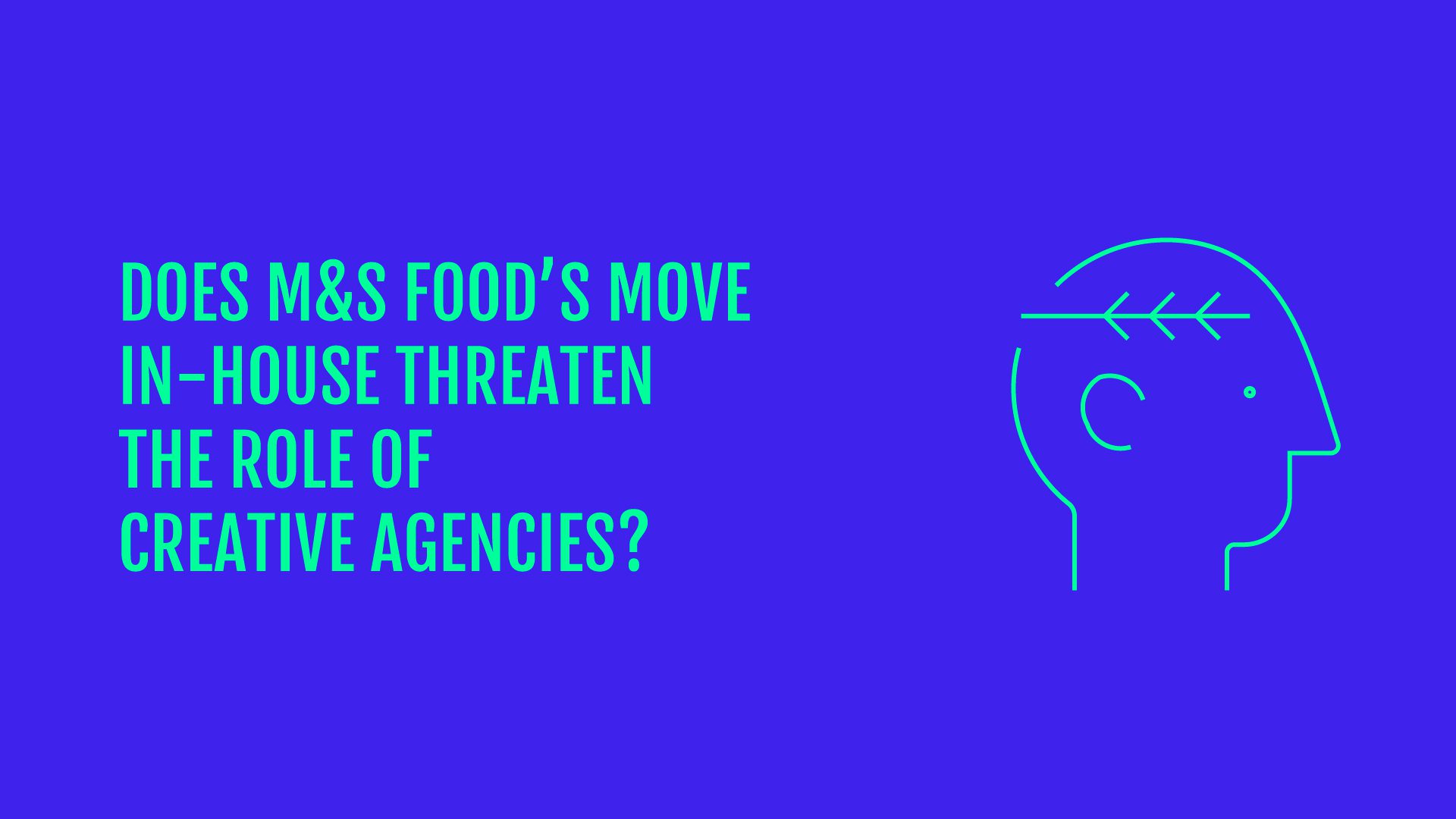 Industry figures are divided on what the future holds for brands and agencies.
Industry figures are divided on what the future holds for brands and agencies.
Earlier this week it emerged that Marks & Spencer is developing a sizeable in-house creative capacity that will allow it to pare back its relationship with ad agency Grey London.
The in-house team of six people will handle the creation and production of all advertising assets, including TV ads.
M&S Food said the strategic shift will allow the brand to have more agility and flexibility to work with a broader range of external partners.
So is the change indicative of a future where brands hand out less work to creative agencies?
Nicola Wardell
Managing director, The Agency, Specsavers
It’s exciting to be part of this rapidly growing “sub-sector” of adland. But I don’t think it rings the death knell for creative agencies.
Specsavers has never used an external creative agency (we were in-housing before in-housing was a thing), but we do rely heavily on our partnerships with media, PR and social agencies. Bringing the outside in, they are critical to staying relevant.
I think we’ll see more clients adopting a similar hybrid model but playing to the cultures of their organisation. Creative in-housing works for us, because we have creativity and partnership in our DNA. More data-led organisations, might bring aspects of media buying in-house.
The bigger threat to adland is the talent drain, as more of us are starting to see the real benefits of moving client-side; truly having a seat at the top table, skin in the game of the business, as well as a welcome cultural shift. It is anything but the “sell-out” it was once perceived to be.
Charlie Carpenter
Chief executive, Creativebrief
This is a significant move from a sizeable advertiser and it would be foolish to dismiss it out of hand. But before the industry races headlong into self-destructive hysteria, we should also recognise that this is an organisation that has been under pressure for a number of years now and one operating in a sector that has been decimated and fundamentally changed by the events of the past 12 months.
So, no, I don’t feel this move points to a declining role for creative agencies. What it does point to is a willingness for brands to experiment more and to trial new ways of working out of necessity; not simply to rely on long-held ideas about how large clients traditionally work best with agency partners. That in turn points to a need for agencies to build a credible commercial model around delivering exceptional creativity for their clients and to reinforce the transformational business advantage that this brings – something few brands that have gone down the in-house route have ever managed to achieve.
Sharon Whale
CEO of global markets and operations, Oliver
Yes and no. You could argue that M&S’s new in-house team is symbolic of the declining role of creative agencies. But that only applies to the creative agencies that aren’t evolving at the same speed as brands. Some are. Some aren’t.
The acceleration of ecommerce has given brands another new normal to contend with today – and they’re rising to the challenge. But it calls for more digital content specialists in a more dedicated capacity.
In 2021 – with resource, budget and time undoubtedly pinched as businesses recover from the pandemic – brands are asking, how can I operate more effectively within my ever expanding and more complex marketing ecosystem? And, at the same time, how can I drive better performance while being more cost efficient?
Finding the right way to bring talent closer to the brand, in- house, really is the only solution; the brand and the creative team are aligned on the same goals, are closer to the data and generally just closer to the action. The brand gets specialists 100% of the time. It’s cheaper by default, because it’s faster.
In-housing is no longer the trend but an established and proven way to do better marketing, which is why M&S Food’s move to in-house is not a surprise. This is a legacy brand that is embarking on an era of transformation in order to reach consumers in their social commerce-led buying journeys as well as gain long-term relevancy. I believe that we will see many more brands doing the same in 2021 as they look to alternative, hybrid and bespoke models for their marketing output.
Rania Robinson
CEO and partner, Quiet Storm
Since I can remember and long before the decline of the creative agency debate was being had, we’ve worked with brands who have in-house creative. It no doubt leads to a different kind of relationship but certainly not, in my opinion, a decline.
At its best, it leads to more creative collaboration, which can lead to much better work. The agency’s value shifts to a more focused and potentially exciting role. In our experience there becomes more of a need for fresh strategic and creative thinking versus day-to-day business as usual, which, arguably, is better placed and more efficient in-house. This gives creative agencies a greater opportunity to deliver transformational ideas, which is where our real value has always been.
John Owen
Partner, WDC London
There are definitely lessons to be learnt from the trend towards in-housing. By their nature, in-house teams are closer to the marketers. This can be a double-edged sword, but the best IHAs, such as those we’ve worked with at BBC Creative and Specsavers, use proximity to their advantage.
It’s telling that although these teams have their own identities, they still very much regard their “clients” as colleagues. They spend time with them and seek to understand their needs. As a consequence, they get when something just has to be done, so they don’t push back at the wrong moments. But they’re also better equipped to challenge when it’s right to do so.
So if I were running a creative agency today, I’d be fixated on one question: how can we get closer to our clients?
Julian Douglas
International CEO, VCCP
No, I do not believe this signals a declining role for creative agencies.
It isn’t a question of either/or, between creative agencies and in-housing, but both. We collaborate with in-house agencies on most of our accounts. More often than not you would struggle to know who works where, given how much they work as one team.
A business thrives on the very best strategic thinking and creative excellence. But this will never exist entirely within one organisation. And an in-house model can often be a more cost-effective solution.
However, business beware when removing the objectivity and constructive competition the best creative talent faces every day in an agency.
As Sir Paul McCartney himself said of his creative partnership with John Lennon, “It was a great time, y’know… And then I went on to do The Frog Song.”
Jon Williams
Chief executive, The Liberty Guild
M&S Food going “in-house” is just the way the world is going. Agencies must be feeling increasingly marginalised. Creatives however, should not.
Brands will always need brilliant creative and strategy. That drives sales. And M&S needs sales. But the way clients buy that is changing. Agency hourly rates just aren’t competitive any more. For most of the work it makes more sense for clients to look elsewhere. And “in-house” is a brilliant way for clients to deliver 80% of that work. It scores off the scale in eight out of 10 measures.
But sometimes, no matter how amazing the client is, it’s hard to get “A-list” creatives and strategists to go to work for a single brand – variety being the spice of life, and all that. But if you can find a way to inject world class talent into your in-house set-up, then you’re onto a winner.
Marcus Brown,
Founder and chief executive, The Great Pitch Company
It would be a great shame if our industry simply sees the rise of in-house agencies as a threat to creative agencies.
Those agencies that see the shift, and embrace it, will be the ones that succeed. There will always be a requirement for agencies that can bring an alternative perspective. But the industry should work collaboratively rather than competitively with this new phenomena.
Much of the industry, wrongly in my view, saw procurement as the enemy. The smart agencies that worked collaboratively profited. Similarly, those agencies that embrace the in-house revolution will be the ones that succeed.



